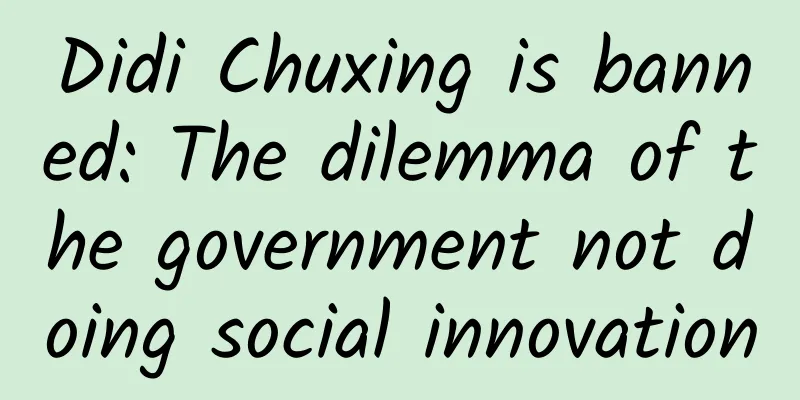Didi Chuxing is banned: The dilemma of the government not doing social innovation

|
Not long after Didi Chuxing was launched in August 2014, the Shanghai Municipal Transportation Commission announced that Didi Chuxing was a black car and its operation was illegal. Then on the 26th, 12 Didi Chuxing cars were seized, of which the drivers of 5 cars were fined 10,000 yuan each, and the remaining 7 cars are still under investigation. This matter involves social innovation, and there are actually many things worth exploring. I saw Yang Miao post an article before, " Why can't Shanghai produce Jack Ma? Because there are idiots like traffic control officials. " I feel that although there is some truth in it, it is still a bit unfinished, so I also wrote an article to interpret this matter from a more macro perspective. Three stories on sharing and ownership The first story is about cloud computing. Cloud computing has become a hot word in recent years. AWS is the most successful one in foreign countries. However, software giants such as Microsoft are anxious to catch up as they are about to be left behind. Judging from the actions of Microsoft CEO Nadella, the cloud may have been raised to a higher position than Windows within Microsoft. There are many types of cloud computing, but the most basic idea is to move from proprietary to shared. Originally, everyone had to buy their own servers, but the idle rate was very high and it was not enough during peak hours. If someone can provide virtual servers, dynamically expand capacity, and have cost advantages, why not use it? Therefore, sharing is one of the main driving forces of cloud computing. The main obstacle is security. If the cost advantage cannot offset the security concerns of enterprises or individuals, then this model will not work. The second story comes from a book. Recently, Jeremy Rifkin, the author of "The Third Industrial Revolution", published a new book called "Zero Marginal Cost Society". The subtitle of this book is "A New Economic Era of Internet of Things, Cooperation and Win-win". The book spends a lot of space to explain an economic model based on sharing. Chapter 12 mentions logistics sharing. In the section on logistics sharing, the author points out the fundamental reason why sharing is more efficient than proprietary: 1. The load factor of most vehicles is very low. In the United States, it is 60%, and in many places it may be only 10%. 2. Manufacturers, wholesalers, and distributors often store goods far away from their final destination. 3. Low logistics efficiency results in dealers being unable to deliver goods. 4. Product transportation often has to take detours on the route. (Note: This should be related to the second point) 5. The lack of common standards and protocols makes it impossible for logistics companies to share logistics resources and improve efficiency. The author believes that the current model should be switched to a shared model, and delivery should be distributed, such as: The first driver delivers the goods at a nearby center and then returns with another trailer of goods; the second driver will load the goods and send them to the next center on the route, which can be a port, railway freight yard, etc. The economic benefits are obvious and easy to measure (in the example given by the author, the delivery time can be shortened by half), but in order to achieve this goal, the first thing to solve is the sharing problem among logistics companies. If the warehouse and distribution center cannot be shared, then no matter how good this wish is, it will always be on one side of the water. The last story is about Didi Chuxing. In the abstract, the situation of Didi Chuxing is very similar to the above-mentioned logistics and cloud. From the perspective of car use, there are obviously various peaks, and in order to avoid wasting taxis, it is inevitable that they cannot be configured according to the peak situation, so the reality must be that the more you want to use a car, the less cars there are. From the perspective of vehicle ownership, there must be a large amount of idle capacity. The only way to break through these two must be a suitable sharing method, and the entry standards for sharing are actually a matter of details. If the resistance to sharing in warehousing and logistics may come from within the logistics company, then judging from the actions of the Shanghai Transportation Commission, the great resistance to sharing in car use seems to come from the regulatory level. As for more specific reasons, such as laws, awareness, and interest patterns, this article will not cover them. The transition from proprietary to shared is actually a transformation in terms of model. The above three stories respectively reflect three sources of obstacles: either from the subject that needs to be transformed, such as logistics companies; or from the customers that need to be faced after the transformation, such as enterprises that may not be willing to use cloud services; or from the regulatory level. The more it involves real infrastructure (energy, transportation, etc.), the greater the resistance from the regulatory level may be. In terms of difficulty in solving, the resistance from customers is the simplest, because as long as the benefits are large enough, customers will make rational choices; resistance from enterprises is slightly more difficult, because it requires a good spirit of cooperation, and it is difficult to cooperate with those who always believe in knowing each other (for example: the cooperation between Baidu and 360, Meizu and Xiaomi will obviously be difficult), and the last one is the most difficult, because it will involve many non-commercial and complex factors related to people (for example: the solution of things like Didi special cars). I have previously written an article titled " Searching for the Light of Civilization in the Dark Forest " to explore the difficulties of inter-enterprise cooperation. I will not go into details here. This article mainly explores the last difficulty. The Dilemma of Social Innovation The thinking framework in the book "The Innovator's Dilemma" can also be used to analyze social innovation. The main theme of this book is not complicated. It says: When a company is very strong in a certain aspect, such as Kodak's film cameras, it will form a collaborative way of values, processes, and resources around this strong point. This way is very similar to a shell, which constantly strengthens the things inside the shell and puts the things outside the shell aside and abandoned. When film cameras were Kodak's main source of profit, it was difficult for it to make digital cameras, because this job was new, so it was definitely risky and hard work, and the initial profit was low and not much money could be made. Who would do such a thing if they were normal and rational? Therefore, the market disruptors are often the loser companies. They cannot fight the original overlords on the front battlefield, so they can only do some marginal things first and earn some hard-earned money, but as long as the technology has potential, they may overthrow the overlords of the previous era in the future. This framework can also be applied to Didi’s private car business. A collaborative way of values, processes, and resources has been formed around the original way (rental, etc.). This collaborative way may include interest distribution, employment, stability, political correctness, law, etc. If this new way of sharing is allowed to take off, it will inevitably break the original pattern and run the political risk of new things going wrong. What is more troublesome than corporate innovation is that Kodak will not do it in the enterprise, but Canon will do it. However, in social innovation, if the government does not do it, you cannot get around it. In order to break this dilemma of social innovation, there are only two ways, either breaking the law (including walking on the edge) or hoping for enlightenment at the regulatory level. There have actually been several similar things since the reform and opening up. The two most typical ones are the household contract responsibility system in Xiaogang Village and Shazi Guazi. One affected the basic land system in rural areas, and the other affected the rise of township enterprises. It can be said that the handling of these two things actually had a profound impact on our lives today, but they were basically completed with the cooperation of "breaking the law" and enlightenment at the top level. As far as social innovation is concerned, in order to break the dilemma, it is indeed appropriate to encourage more private attempts in places where the law does not explicitly prohibit them. Next, the regulatory level should use the Internet and other means to quickly collect feedback and then establish an appropriate regulatory mechanism. It is not appropriate to quickly kill it, which will cause the already weak innovation forces to die quickly and lose the future. What happens if social innovation stagnates? If reform and opening up is the most critical point in social change, then the second point will most likely be reached with the promotion of the Internet. The Internet and other technological developments have undoubtedly brought many benefits, such as e-commerce making it cheaper and more convenient for us to buy things, and Weibo and WeChat allowing us to communicate with people better, etc. However, there is a key point that is closely related to social innovation. If it is not handled properly, it will turn technological development into a bad thing. This point is the employment issue. The basic trend of our era is that fewer people are handling large undertakings. We should not forget that WeChat is worth 50 billion US dollars but only employs a few hundred people. Of course, if we carefully compare the annual output value of Tencent and Anshan Iron and Steel, this contrast will be more obvious. Through the Internet, the leverage ratio of many jobs has become super high, and a small number of people can meet the needs of a large number of people. Large manufacturing companies (such as steel mills) can easily absorb people into employment, but as the level of automation increases, most people will be eliminated from their jobs (the book "The Zero Marginal Cost Society" lists detailed figures for the United States on this point). Although it is impossible to accurately calculate the specific number, it is certain that the current social structure cannot afford the employment of so many people under the influence of automation and high leverage. This change is being accelerated by the Internet itself and technology, so a key question is what will the remaining people do? This requires gradual social innovation. Social innovation needs to be gradual, otherwise it will be a revolution. The change from proprietary to shared may not necessarily solve this problem, but logically speaking, only universal connections between people, sharing of resources and provision of personalized services can solve this problem, or at least this is an idea. So my personal opinion is that innovations like Didi Chuxing should not only not be prohibited, but should be encouraged, of course, this should be included in a specific legal framework. Conclusion In the face of the technological tide, there is no way out for anyone. Unless a nuclear war or something like that leads to the destruction of the world, I firmly believe that technological development will only push us forward, and technological development will definitely reconstruct all kinds of relationships. At this time, being purely conservative and rejecting new things at a stroke is not feasible. This may lead to bigger problems in the long run. People who play the role of regulators are more suitable to face such changes with an embracing attitude. The only trouble is that in terms of the current situation, if we want to form a positive feedback loop, the promotion and thinking of enterprises seem to be sufficient, but without top-down enlightenment, things will inevitably get stuck somewhere. As a winner of Toutiao's Qingyun Plan and Baijiahao's Bai+ Plan, the 2019 Baidu Digital Author of the Year, the Baijiahao's Most Popular Author in the Technology Field, the 2019 Sogou Technology and Culture Author, and the 2021 Baijiahao Quarterly Influential Creator, he has won many awards, including the 2013 Sohu Best Industry Media Person, the 2015 China New Media Entrepreneurship Competition Beijing Third Place, the 2015 Guangmang Experience Award, the 2015 China New Media Entrepreneurship Competition Finals Third Place, and the 2018 Baidu Dynamic Annual Powerful Celebrity. |
<<: Ten years later, China's mobile phone bull market is on the rise
>>: The growing pains of WeChat: Where should subscription accounts go?
Recommend
Meizu App Store promotion account opening qualification requirements!
What qualifications are required to open an accou...
Rejecting the middle-aged greasy Toyota's new Asia Dragon also plays sports
According to Toyota's current new car plan, t...
Perfect World Novel Free Reading Full Text: Is it necessary to promote the website during the holidays?
For many webmasters and enterprises, before the h...
Beware of the violent spring wind - Looking northwest, we see the wolf
1. Gentle Spring Breeze VS Violent Spring Breeze ...
Brother Chen's private training - the love master teaches you the secrets of mastering the emotions of both sexes
Course catalog: Private training teaches you datin...
You are not fat, but your belly is big? There are 6 major health risks hidden behind the small belly, don't ignore them
There are many kinds of fat. Some people are fat ...
Stop being emo! Beware of thyroid disease
Recently, #women with depression are more likely ...
How to do competitive product analysis? 4 elements + 6 core methodologies to teach you how to quickly master the essence of competitive product analysis
When we get involved in competitive product analy...
12 channels for selling goods through live streaming!
Previously, I shared with you how to build a circ...
Learn breast enhancement yoga for 15 minutes a day, and keep your breasts plump and firm until you are 50 years old
The fastest way to enlarge breasts. The whole pro...
User operation: operation skills and channel establishment for user feedback
In operational work, there is a position that req...
Practical tips for app promotion! App Marketing Strategy
1. Overall Logic There is only one logic in runni...
Free money Lujiang March 2022 courses
Free Money Lujiang March 2022 course resources in...









